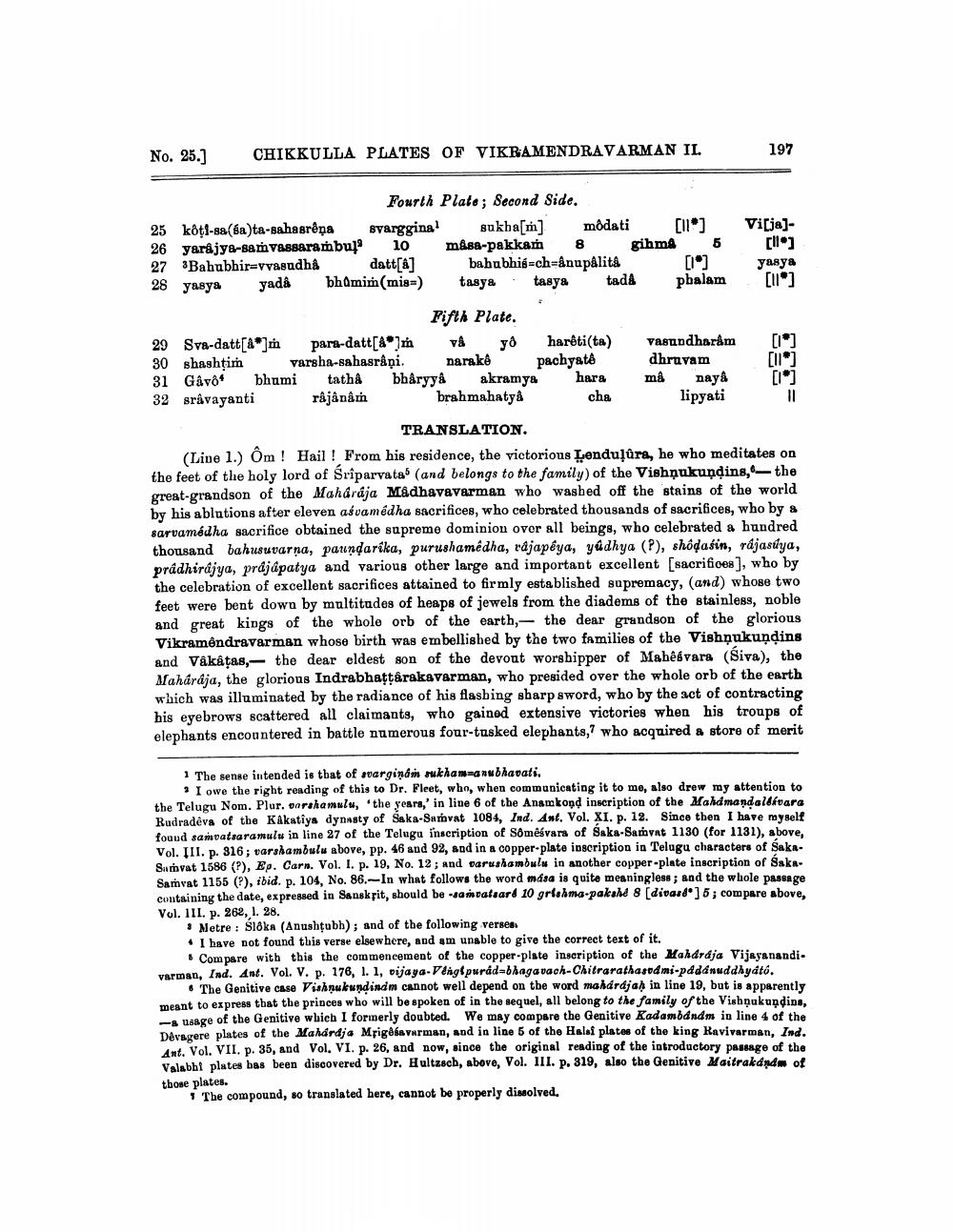________________
No. 25.]
CHIKKULLA PLATES OF VIKRAMENDRAVARMAN IL
197
Fourth Plate ; Second Side. 25 koti-sa(ka)ta-sahasrêņa svargginal sukba[m] môdati [11] 26 yard iya-samvassarambuj 10 m&ba-pakkam 8 gihma 5 27 3Bahubhir=vyasudha datt[a] bahubhig=chranu pålita 28 yasya yada bhQmim(mis) tasya - tasya tada pbalam
Vi[ja]
[ll] yasya [11]
Fifth Plate. 29 Sva-datt[A] para-datt[8*]h và yố harlti(ta). vasundharam [*] 30 shashtim varsha-sahasråņi. Darake pachyate dhruvam 31 Gâvô bhumi tatha bharyya akramya hara mô naya [1] 32 sråvayanti rájánam
brahmahatya cha
lipyati
11 TRANSLATION. (Line 1.) Om ! Hail! From his residence, the victorious Lenduļura, he who meditates on the feet of the holy lord of Sriparvata' (and belongs to the family) of the Vishnukundins, the great-grandson of the Maharaja Madhavavarman who washed off the stains of the world by his ablutions after eleven asvamédha sacrifices, who celebrated thousands of sacrifices, who by a sarvamédha sacrifice obtained the supreme dominion over all beings, who celebrated a hundred thousand bahusuvarna, paundaríka, purushamédha, rdjapéya, yadhya (?), shodasin, rajasuya, pradhirajya, prdjúpatya and various other large and important excellent (sacrifices], who by the celebration of excellent sacrifices attained to firmly established supremacy, (and) whose two feet were bent down by multitudes of heaps of jewels from the diadems of the stainless, noble and great kings of the whole orb of the earth, the dear grandson of the glorious Vikramêndravarman whose birth was embellished by the two families of the Vishnukundins and Vâkâțas, - the dear eldest son of the devout worshipper of Mahêóvara (Siva), the Maharaja, the glorious Indrabhattarakavarman, who presided over the whole orb of the earth which was illuminated by the radiance of his flashing sharp sword, who by the act of contracting his eyebrows scattered all claimants, who gained extensive victories when his troups of elephants encountered in battle numerous four-tasked elephants, who acquired & store of merit
1 The sense intended is that of pargindi mukham anubhavati,
9 I owe the right reading of this to Dr. Fleet, who, when communicating it to me, also drew my attention to the Telugu Nom. Plur. darahamulu, 'the years,' in line 6 of the Anamkond inscription of the Maldmandaldivara Rudradevs of the Kakatiya dynasty of Saka-Sumovat 1084, Ind. Ant. Vol. XI. p. 12. Since then I have myself fouud samvatsaramulu in line 27 of the Telugu inscription of some vars of Saka-Samyat 1130 (for 1131), above, Vol. III. p. 316; varshambulu above, pp. 46 and 92, and in a copper-plate inscription in Telugu characters of SakrSamvat 1586 (P), Ep. Carn. Vol. I. p. 19, No. 12; and warushambulu in another copper-plate inscription of SakaSamvat 1155 (R), ibid. p. 104, No. 86.-In what follows the word mása is quite meaningless; and the whole passage containing the date, expressed in Sanskrit, should be sa mataard 10 grishma pakald 8 (divand] 6; compare above, Vol. III. p. 262, 1. 28.
3 Metre: Slóka (Anushțubh); and of the following verses • I have not found this verse elsewhere, and am unable to give the correct text of it.
* Compare with this the commencement of the copper plate inscription of the Maldrdja Vijayanandivarman, Ind. Ant. Vol. V. p. 176, 1.1, vijaya. Vengfpuradabhagavach-Chitrarathasodmi-pdddnuddhydto.
The Genitive case Vishnukundindm cannot well depend on the word mandrdjah in line 19, but is apparently meant to express that the princes who will be spoken of in the sequel, all belong to the family of the Vishnukundins,
age of the Genitive which I forinerly doubted. We may compare the Genitive Kadambandm in line 4 of the Davacere plates of the Maldrdja Mrigábavarman, and in line 5 of the Halal plate of the king Ravivarman, Ind. Aut. Vol. VII. p. 35, and Vol. VI. p. 26, and now, since the original reading of the introductory passage of the Valabht plates bas been discovered by Dr. Hultzsch, above, Vol. III. p. 319, also the Genitive Maitrakdndw of those plates.
The compound, so translated here, cannot be properly disolved.




